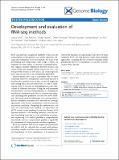Development and evaluation of RNA-seq methods
Author(s)
Levin, Joshua Z.; Adiconis, Xian; Yassour, Moran; Thompson, Dawn; Guttman, Mitchell; Berger, Michael F.; Fan, Lin; Friedman, Nir; Nusbaum, Chad; Gnirke, Andreas; Regev, Aviv; ... Show more Show less
DownloadLevin-2010-Development and evaluation of RNA-seq methods.pdf (169.8Kb)
PUBLISHER_CC
Publisher with Creative Commons License
Creative Commons Attribution
Terms of use
Metadata
Show full item recordAbstract
RNA-seq provides insights at multiple levels into the transcription of the genome as it yields sequence, splicing and expression-level information. We have been developing and comparing a wide range of RNA-seq methods for their ability to annotate transcribed genomic regions, identify differences between normal and cancer states, and quantify mRNA expression levels. We will present results in two areas: (i) strand-specific RNA-seq; and (ii) RNA-seq starting from total RNA.
Strand-specific RNA-seq is a powerful tool for novel transcript discovery and genome annotation because it enables the identification of the strand of origin for non-coding RNA and anti-sense RNA, as well as defining the ends of adjacent or overlapping transcripts transcribed in different directions. Using the well-annotated Saccharomyces cerevisiae transcriptome as a benchmark, we directly compared seven library construction protocols, including both published and our own novel methods. We found marked differences in strand-specificity, library complexity, evenness and continuity of coverage, agreement with known annotations, and accuracy for expression profiling. Weighing the performance and ease of conducting each method, we identified the dUTP second strand marking [1] and the Illumina RNA ligation methods as the leading protocols, with the former benefitting from the current availability of paired-end sequencing. Our analysis provides a comprehensive benchmark, and our computational pipeline is applicable for assessment of future protocols in other organisms.
RNA-seq methods that do not require the purification of mRNA will be valuable for several applications, including samples with low input amounts and/or partial degradation. In these experiments, it is necessary to reduce the fraction of sequencing reads derived from ribosomal RNA. We will present results from multiple approaches, including the use of Not-So-Random (NSR) primers for reverse transcription [2] and the NuGEN Ovation RNA-Seq kit.
Description
This article is part of the supplement: Beyond the Genome: The true gene count, human evolution and disease genomics
Date issued
2011-10Department
Massachusetts Institute of Technology. Department of BiologyJournal
Genome Biology
Publisher
BioMed Central Ltd.
Citation
Levin, Joshua et al. “Development and Evaluation of RNA-seq Methods.” Genome Biology 11.Suppl 1 (2010): P26.
Version: Final published version
ISSN
1465-6906
1474-7596